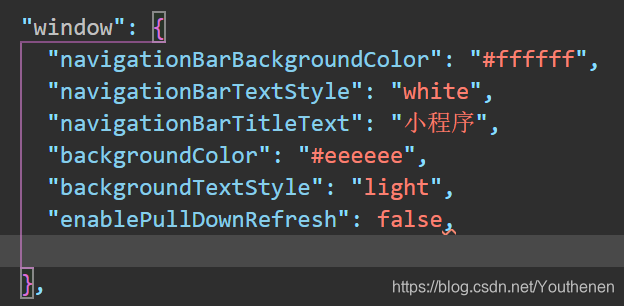小程序自定义导航栏
本文共 2411 字,大约阅读时间需要 8 分钟。
文章目录
一. 微信自带的导航栏
小程序有自带的导航栏,可以通过app.json中的
二.自定义导航栏
1.设置custom
若需要自定义导航栏,即实现不同页面有不同标题,或者不同的顶部导航栏样式,则首先需要在app.json中的window添加"navigationStyle": "custom"。

2.component
接着可以通过自定义组件components来自定义。
在小程序的根目录(即与app.json文件夹同在的那个文件夹)创建components文件夹。之后创建组件的名称文件夹(在我这里用的是nav)。 鼠标右键点击nav,点击创建component,即可以生成以下四个文件。(这四个文件用于写组件的样式等
nav.json
{ "component": true, "usingComponents": { }} nav.js
// components/nav/nav.jsComponent({ properties: { title: { // 设置标题 type: String, value: '' }, cover_state: { // 控制页面padding-top type: Boolean, value: false }, show_bol: { // 控制返回箭头是否显示 type: Boolean, value: true }, my_class: { // 控制样式 type: Boolean, value: false } }, /* 组件的初始数据 */ data: { type: "组件", bar_Height: wx.getSystemInfoSync().statusBarHeight // 获取手机状态栏高度 }, /* 组件的方法列表 */ methods: { goBack: function () { // 返回事件 console.log("退后") wx.navigateBack({ delta: 1, }) } }}) nav.html
{ {title}}
/* components/nav/nav.wxss *//* 顶部导航 */.status-bar { width: 100%; z-index: 99999; position: fixed; top: 0; }.goBack{ position: absolute; top: 15rpx; font-size:12pt;}.goBack image{ width: 40rpx; height: 40rpx; padding: 12rpx 20px 0 30rpx;}.tabar { display: flex; justify-content: center; background-color: rgba(0, 0, 0, 0); }.tabar2{ background: transparent !important;}.tabar2 text{ color: #fff !important; font-weight: lighter !important;}.tabar text { height: 44px; line-height: 44px; padding: 0 30rpx; color: white; font-size: 12pt; font-weight: bold;}.tabar .active { color: #fff;} 3.引用组件
写好组件的四个文件之后,就是引用阶段。
在需要使用自定义导航栏的页面**.json加入组件路径,注意这里的路径要根据你自己的实际情况**去写。
"usingComponents": { "component":"../../components/nav/nav" } - 若想要获取状态栏的高度作为component外面的盒子的padding-top,
| statusBarHeight | 状态栏的高度 |
|---|---|
| screenHeight | 屏幕高度 |
可以在页面.js中用wx.getSystemInfoSync().statusBarHeight 获取。
data:{ bar_Height: wx.getSystemInfoSync().statusBarHeight widnowH : wx.getSystemInfoSync().screenHeight, } 在页面.wxml写入:
这样的话,就有一个自适应手机型号高度的导航栏。
 如此一来,便可以通过修改nav.wxml来修改导航栏上的东西了。
如此一来,便可以通过修改nav.wxml来修改导航栏上的东西了。 

- 也可以不获取状态栏高度。这样的话,下面的元素就会直接往上移,就可以实现这种效果


三.参考资料
https://blog.csdn.net/qq_33744228/article/details/83656588
你可能感兴趣的文章
nginx负载均衡器处理session共享的几种方法(转)
查看>>
nginx负载均衡的5种策略
查看>>
nginx负载均衡的5种策略(转载)
查看>>
nginx负载均衡的五种算法
查看>>
Nginx负载均衡详解
查看>>
Nginx负载均衡(upstream)
查看>>
nginx转发端口时与导致websocket不生效
查看>>
Nginx运维与实战(二)-Https配置
查看>>
Nginx部署_mysql代理_redis代理_phoenix代理_xxljob代理_websocket代理_Nacos代理_内网穿透代理_多系统转发---记录021_大数据工作笔记0181
查看>>
nginx部署本地项目如何让异地公网访问?服务器端口映射配置!
查看>>
Nginx配置HTTPS服务
查看>>
Nginx配置Https证书
查看>>
Nginx配置http跳转https
查看>>
Nginx配置ssl实现https
查看>>
nginx配置ssl证书https解决公网ip可以访问但是域名不行的问题
查看>>
Nginx配置TCP代理指南
查看>>
NGINX配置TCP连接双向SSL
查看>>
Nginx配置——不记录指定文件类型日志
查看>>
nginx配置一、二级域名、多域名对应(api接口、前端网站、后台管理网站)
查看>>
nginx配置中的服务器名称
查看>>